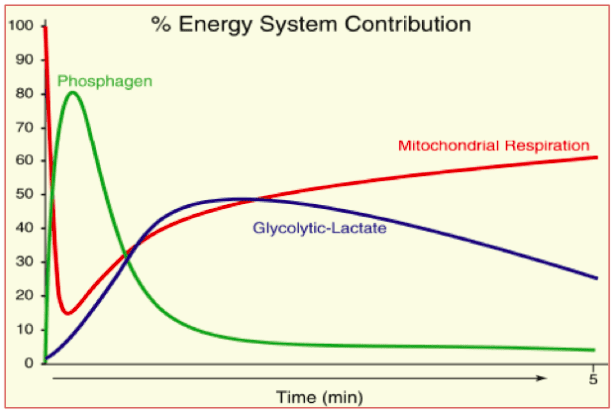
Energy Systems: Pt. 2 Application
// QUICK RECAP
- Phosphagen system: Forming ATP by using creatine phosphate or two ADP molecules; this pathway yields the highest ATP turnover rate
- Glycolysis: From blood glucose or muscle glycogen; can activate very early on in muscle contraction
- Mitochondrial respiration/Aerobic System: The use of oxygen in the mitochondria

Here is an example of how all three systems can work together:
A 400-meter race, is not only dependent on the phosphagen system, but also largely on a slower pathway of ATP production, glycolysis, and EVEN the slowest pathway of producing ATP, mitochondrial respiration or the Aerobic System.
If the duration of maximal effort work is sustained, the absolute power output will by default begin to decline, because of the shift in the energy system that is most dominant in resynthesizing ATP. Essentially, energy systems represent a continuum that ranges from rapid energy production to slow energy production.
Training the Phosphagen System:
Recommendation: Exercises utilizing maximally high rates of force development, such as Olympic weightlifting, Plyometrics, Heavy Resistance Training. Longer rest periods because this system takes a lot of time to replenish its ATP (Refer to Part 1). Supplementation with Creatine Recommended.
Typical routine: Max Lifting
- 3-6 sets of 1-3 reps @ 90% or Above of 1RM
- 5 minutes rest between sets
- For improving performance: train 4 times a week
- For maintenance: train 2 times a week
Typical routine: Dynamic Lifts
- 3-10 sets of 1-3 reps @ 40-60% of 1RM
- 2-3 minutes rest between sets
- For improving performance: train 3 times a week
- For maintenance: train 2 times a week
Typical routine: Plyometrics
- 2-6 sets of 1-5 reps of throws/jumps for upper/lower body
- 1:30 - 2 minutes rest between sets
- For improving performance: train 4 times a week
- For maintenance: train 2 times a week
Training the Glycolytic System:
Recommendation: Usage of adequate carbs is a must to even have the energy to maintain the ability to operate in this system. Incomplete Rest periods work (Doing more reps before full recovered). Or, Allowing adequate rest after performing a given amount of work during the specific time frame ( 10 sec ~ 2 min).
Typical routine: "Body Building"
- 3-6 sets of 6-15 reps
- 1 minute - 1:30 sec rest between sets
- For improving performance: train 5 times a week
- For maintenance: train 2 times a week
Typical routine: Interval Training (Tabata Training)
- 8 sets of 20 sec on / 10 sec off of a particular exercise.
- Incomplete Rest Recommended
- For improving performance: train 3 times a week
- For maintenance: train 2 times a week
Typical routine: Running
- 2-4 sets of 400 m sprint
- 1:2 -1:5 Work to rest ratio (depending on goals)
- For improving performance: train 4 times a week
- For maintenance: train 2 times a week
Training the Aerobic System:
Recommendation: Usage of adequate carbs is a must, as well as consumption of the right types of "Fats". Allow adequate rest after performing a given amount of work during the specific time frame. This system, once improved will help recovery for the other two systems.
Typical routine: Running/Cycling/Rowing/Walking
- 10-15 min of steady state cardio
- 1-2 Sessions by themselves (30 min - 1 hr)
- Zone 2 Training: 60-70% of Max Heart Rate (220-Age)